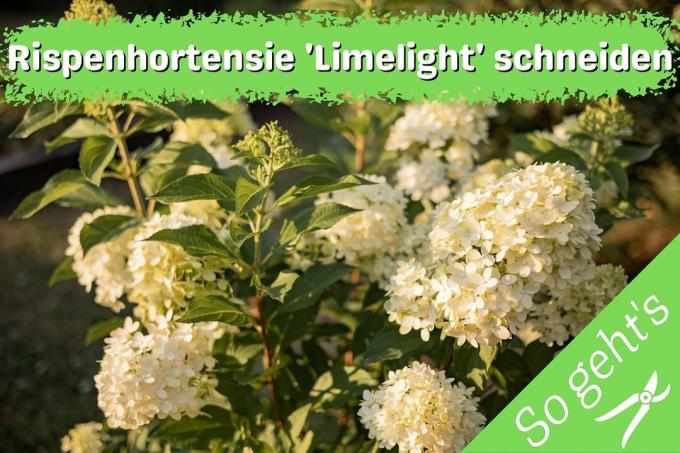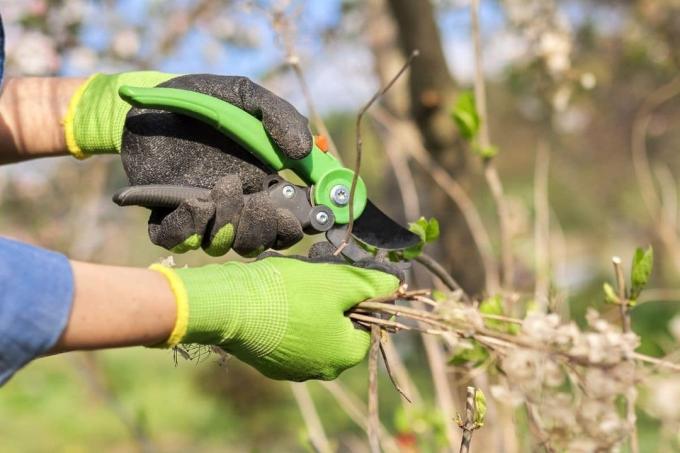
Table of Contents
- time
- Cutting tool
- Types of cuts
- Radical cutback
- Half cut back
- Standard cut
- Thin out
- frequently asked Questions
Since the panicle hydrangea 'Limelight' develops its inflorescences exclusively on annual wood, it is urgently necessary to prune it once a year in spring. The most important information about pruning can be found in these instructions.
In a nutshell
- Cut limelight in spring
- Observe the prohibition of cutting between March and September
- Use only clean and sharp tools
- different cuts and upbringing options are possible
- also clear annually
time
Because the panicle hydrangea 'Limelight' is highly insensitive to frost, it can be pruned as early as autumn. In practice, however, early spring between February and April has proven its worth. At this point in time, in addition to the actual pruning, all shoots that have kinked and died over the winter can be removed.
In order to keep the stress load for the plant as low as possible, the following weather conditions should be met:
- cloudy sky
- dry weather
- frost-free outside temperature

Notice:Section 39 of the Federal Nature Conservation Act prohibits the pruning of trees between the 1st March and the 30th September each year due to wildlife conservation. Maintenance measures are excluded from this. You should also discuss these - depending on the scope - with the responsible nature conservation authorities.
Cutting tool
For the cutting measures, clean, better still sterile and sharp Tool indispensable. Depending on the thickness of the individual branches, the following tools are available:
- Secateurs
- Loppers
- saw

Types of cuts
In practice, three basic variants are common for pruning the 'Limelight' panicle hydrangea. These include:
- radical cut back
- half cut back
- Standard cut
The most common way of doing this is radical cutback. This enables controlled growth of the panicle hydrangea and keeps the plant small and compact.

Notice: In the event of a planned change of location, the roots should also be proportionally shortened in addition to the external shoots. This enables rapid rooting in the new place with constant shoot growth at the same time.
Radical cutback
Basically applies to everyone Panicle hydrangea varieties like 'Limelight' also that a strong pruning promotes equally strong budding. In order to create a handsome appearance, radical cutting of the outer shoots to a maximum of two pairs of buds is recommended. Between three and four pairs of buds can remain inside.
The process of radical pruning follows the instructions below:
- Shorten branches to a length of about 15 centimeters
- The point of intersection should be a pair of buds
- Remove dead shoots lying inside

Notice: Young plants, in particular, should not be cut back too much in the first years in order not to endanger their stability.
Half cut back
The intersection points for the half cut back are a lot higher than in the aforementioned variant. Using this cutting technique, the volume of the plant can be steadily increased over several years to a height of two meters without increasing the risk of the inside becoming bare. The procedure is very similar to that of radical pruning:
- Cut branches by a third, but no more than half
- The beginning of the cut should be a pair of buds
- Cut out dead wood and branches inside
The plants, which have been shortened in the half-cut form, usually show a strong increase in height and width, but this is at the expense of the development of flowering shoots.
Notice: The cut type of half pruning is particularly suitable for panicle hydrangeas that have theirDevelop flowers on biennial wood. This variant is therefore not recommended for the Limelight variety.
Standard cut
If you want to raise your panicle hydrangea 'Limelight' to a high stem, patience and continuity are required. The first pruning should be used to select the future trunk of the tree. For this purpose, the strongest and most straight growing shoot is selected, which is then only slightly shortened. The other branches of the panicle hydrangea, on the other hand, are cut back to a few centimeters above the ground. Furthermore, it is important to pay attention to the upbringing to a high trunk:
- Only shorten the main shoot when the desired height has been reached
- remove old inflorescences
- Cut the crown branches to a length of ten centimeters
- remove further shoots growing on the trunk early
Thin out
In addition to the cutbacks, continuous illumination of the 'Limelight' also contributes to a splendid appearance. Similar to the lilac the plant usually forms two new flower stems at the interfaces. In order to prevent uncontrolled growth in height and width, it is therefore necessary to clear this doubling as early as possible. In principle, it is sufficient to remove one of the two new shoots at a time.
The following are predestined for the lighting:
- weak and meager branches
- inward growing shoots

frequently asked Questions
Despite their high tolerance to pruning, the formation of new shoots and inflorescences is supported by the administration of a special hydrangea fertilizer. This should have high levels of nitrogen and potassium, which are essential for growth.
From November of each year the inflorescences of the panicle hydrangea begin to die off. In many places, the brown panicles are left on the plant until they are cut back in spring, as they provide natural frost protection. Since the panicle hydrangea only develops its inflorescences on annual shoots, cutting the stands in autumn is an exclusively visual matter.
Due to the high cut tolerance, the most common cutting errors, such as omitted clearings and too hesitant cutbacks, can be remedied by means of a radical shortening. In this way, a fundamental rebuilding can be achieved even with perennial plants.



